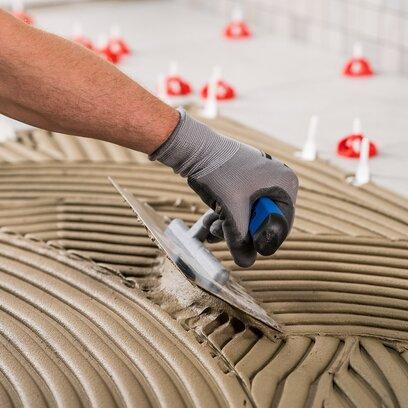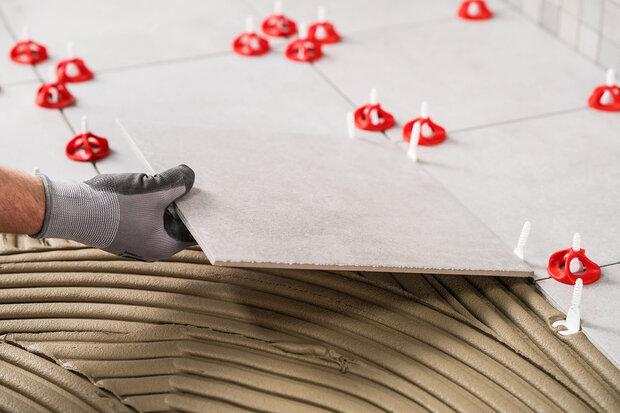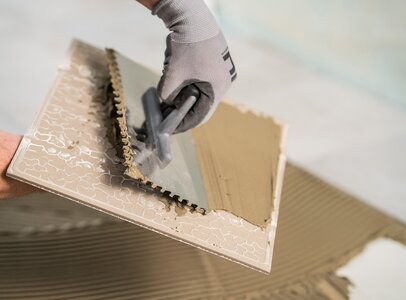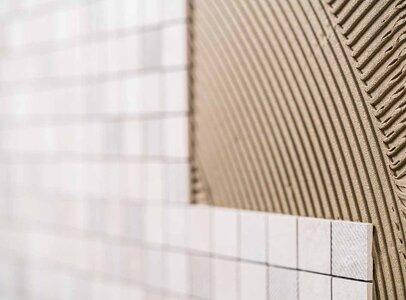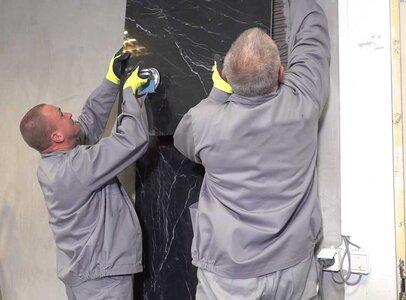Tiling Adhesives
The classification of tile adhesives according to the standard is always indicated on the packaging, but this information often reflects only the minimum values, which are difficult to apply to a specific task. The criteria for choosing tile adhesive are explained in detail below. In general, we recommend using our adhesive selection chart for cold tile installation, which takes into account the most typical loads and conditions, helping you make the right decision.
Adhesive Application Process
If we limit ourselves to a very brief, textbook-level definition, the tiling process can be described as bonding two materials with different properties. It sounds simple, but in practice, it is quite a complex task. To achieve a durable result, when selecting materials, it is necessary to consider not only the basic properties of the tile and the substrate but also a number of other factors that significantly affect the final outcome of the work. This is especially true for the adhesive.
Tile Adhesive Selection Process
The choice of a suitable tile adhesive depends on many factors: the type of tile, the nature of the substrate, environmental conditions and purpose (for example, indoor or outdoor areas, wet zones), specific requirements of the construction project, and other aspects.
Flexible adhesives can compensate for small substrate movements, such as in underfloor heating systems, on sunny balconies, or terraces. They are resistant to deformation and minimize the risk of cracking.
High-strength adhesives are suitable, for example, for areas with heavy foot traffic, workshops, or environments exposed to constant water influence.
For large surfaces or complex tile patterns that require longer working time, Cemix offers products with extended open time, which remain workable for longer and provide sufficient time for tile adjustment.
Tile Adhesive Selection Table
Cemix products for tile adhesives ezen a linken can be accessed. To choose the most suitable material for a specific task, the adhesive selection table for cold tile installation will be helpful (see the illustration below).
Binder of Adhesives for Cold Tile Installation
Among adhesives for cold tile installation, three main types are distinguished based on the binder used: cement-based, dispersion, and reactive synthetic resin adhesives. In addition to these, there are adhesives with other binders, but the three mentioned types account for more than 99% of the products available on the market.
Cement-based adhesives are the most commonly used due to their ease of application, relatively low cost, and good price-to-performance ratio. Dispersion and, in particular, reactive resin adhesives are mainly used for non-absorbent substrates (such as metal, plastic, or glass) and in cases of special stresses (chemical, tensile, etc.).
The classification of tile adhesives for cold installation is defined by two harmonized standards (EN 12002 and EN 12004), according to which adhesives are labeled with the following designations:
- [C] Cement-based adhesive (C1, C2)
- [D] Dispersion plastic-based adhesive (D1, D2)
- [R] Reactive synthetic resin adhesive (R1, R2)
- [1] Mortar or adhesive for standard loads
- [2] Mortar or adhesive for increased loads
- [T] Flexible adhesive with reduced slip
- [E] Adhesive with extended open time (30 minutes)
- [F] Fast-setting adhesive (bond strength of 0.5 N/mm² after just 6 hours)
- [S1] Deformable adhesive with flexibility ≥ 2.5 mm
- [S2] Highly deformable adhesive with flexibility ≥ 5 mm
As an example, the S1 Flex adhesive has the classification C2 TE S1, which means: "Cement-based adhesive with improved strength, deformable, with reduced slip and extended open time."
What does this mean in practice?
-
Increased performance requirements – the adhesive has higher adhesion and compressive strength.
-
Deformability – the adhesive can compensate for tile movements, mainly caused by temperature changes and thermal expansion (especially important for large-format tiles).
-
Reduced slip – tiles installed on vertical surfaces will not slide down before the adhesive sets.
-
Extended open time – within approximately half an hour, the position of the tile can be adjusted if it was placed incorrectly.
Related Articles
